Virgo constellation lies in the southern sky. Its name means “virgin” in Latin. The constellation is represented by the symbol ♍.
Virgo is one of the 12 zodiac constellations, first catalogued by the Greek astronomer Ptolemy in the 2nd century. It contains Spica, one of the brightest stars in the night sky. It also contains the autumn equinox point, which lies close to the star Beta Virginis. This is one of the two points in the sky (the other being in the constellation Pisces) where the celestial equator intersects with the ecliptic. Virgo is the second largest constellation in the sky. The only constellation larger in size is Hydra.
Notable deep sky objects in Virgo include the bright galaxies Messier 49, Messier 58, Messier 59, Messier 60, and Messier 87, the Sombrero Galaxy (M104), the Eyes Galaxies, the Siamese Twins, and the quasar 3C 273.
Facts, location and map
Virgo is the second largest constellation in the sky, occupying an area of 1294 square degrees. It is one of the 15 equatorial constellations. It is located in the third quadrant of the southern hemisphere (SQ3) and can be seen at latitudes between +80° and -80°. The neighboring constellations are Boötes, Coma Berenices, Corvus, Crater, Hydra, Leo, Libra and Serpens Caput.
The constellation name Virgo is pronounced /ˈvɜːrɡoʊ/. In English, the constellation is known as the Maiden. The genitive form of Virgo, used in star names, is Virginis (pronunciation: /ˈvɜːrdʒɪnɪs/). The three-letter abbreviation, adopted by the International Astronomical Union (IAU) in 1922, is Vir.
Virgo belongs to the Zodiac family of constellations, along with Aries, Taurus, Gemini, Cancer, Leo, Libra, Scorpius, Sagittarius, Capricornus, Aquarius and Pisces.
Virgo contains eleven Messier objects: Messier 49 (M49, NGC 4472), Messier 58 (M58, NGC 4579), Messier 59 (M59, NGC 4621), Messier 60 (M60, NGC 4649), Messier 61 (M61, NGC 4303), Messier 84 (M84, NGC 4374), Messier 86 (M86, NGC 4406), Messier 87 (M87, NGC 4486), Messier 89 (M89, NGC 4552), Messier 90 (M90, NGC 4569) and Messier 104 (M104, NGC 4594, Sombrero Galaxy).
Virgo also has 20 stars with known planets, more than any other constellation. The brightest star in the constellation is Spica, Alpha Virginis, with an apparent magnitude of 0.98.
The constellation Virgo contains 17 named stars. The proper names of stars that have been officially approved by the International Astronomical Union (IAU) are Elgafar, Flegetonte, Gar, Guahayona, Heze, Kang, Khambalia, Lich, Malmok, Minelauva, Mönch, Porrima, Spica, Syrma, Vindemiatrix, Zaniah, and Zavijava.
There are two meteor showers associated with the constellation; the Virginids and the Mu Virginids.
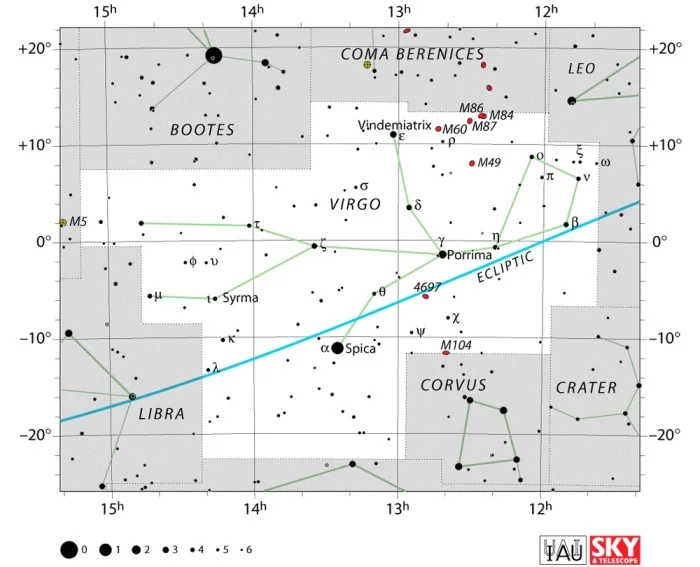
Virgo constellation map by IAU and Sky&Telescope magazine
Virgo myth
The constellation Virgo is usually associated with the Greek goddess of justice, Dike. Dike was the daughter of Zeus and Greek Titaness Themis. Virgo is usually depicted with angel-like wings, with an ear of wheat in her left hand, marked by the bright star Spica. She is located next to Libra, the constellation representing the scales of justice. Dike was also sometimes known as Astraeia, daughter of Astraeus, considered father of the stars, and Eos, goddess of the dawn.
In Greek mythology, Dike lived in the Golden Age of mankind. She was born a mortal and placed on Earth to rule over human justice. The Golden Age was marked by prosperity and peace, everlasting spring, and humans never knowing old age. When Zeus fulfilled the old prophecy and overthrew his father, this marked the beginning of the Silver Age, which was not as prosperous. Zeus introduced the four seasons and humans no longer honoured the gods as they had used to. Dike gave a speech to the entire race, warning them about the dangers of leaving behind the ideals of their predecessors and saying worse was yet to come. Then she flew to the mountains, turning her back on humans. When the Bronze and Iron Ages came and humans started warring among themselves, Dike left the Earth altogether, and flew to the heavens.
In other stories, the constellation Virgo is identified with Demeter, the corn goddess Atargatis, the Syrian goddess of fertility, and Erigone, the daughter of Icarius, who hanged herself after her father’s death. In this version of the myth, Icarius is associated with the constellation Boötes and the star Procyon in Canis Minor represents Icarius’ loyal dog Maera.
Historians Eratosthenes and Hyginus also associate the constellation Virgo with Tyche, the goddess of fortune, even though Tyche is usually depicted as holding the horn of plenty and not an ear of grain. The name of the star Spica, which marks the ear of grain held by the goddess, means exactly that, “the ear of grain” in Latin.
Virgo stars
Spica – α Virginis (Alpha Virginis)
Spica is the brightest star in Virgo and the 15th brightest star in the sky. It has an apparent magnitude of 1.04. It is a rotating ellipsoidal variable star, which is to say a non-eclipsing close binary star system in which the two components do not eclipse each other, but are mutually distorted through their gravitational interaction.
The name Spica comes from the Latin spīca virginis, which means “Virgo’s ear of grain.”
Spica is classified as a blue giant of the spectral types B1 III-IV and B2 V, approximately 260 light years distant from the solar system. It is one of the nearest massive double stars to the solar system. The primary star is midway between the subgiant and giant stage of evolution (spectral class B1 III-IV) and about 12,100 times brighter than the Sun.
The secondary component is a main sequence star of the spectral type B2 V. It is one of the rare examples of the Struve-Sahade effect, which occurs with double-lined spectroscopic binary stars when their spectral lines become weaker and shift toward the red end of the spectrum as the stars move away from the observer. When they approach the observer, however, the lines are shifted toward the blue end of the spectrum. The effect was first observed by the Russian astronomer Otto Struve in 1937.
Located 260 light years away, the primary star is one of the nearest stars sufficiently evolved and massive enough to go out as a Type II supernova.
Spica is classified as a Beta Cephei type variable star, which is to say a main sequence star that exhibits changes in brightness as a result of pulsations of its surface, and is at its brightest at the point of maximum contraction.
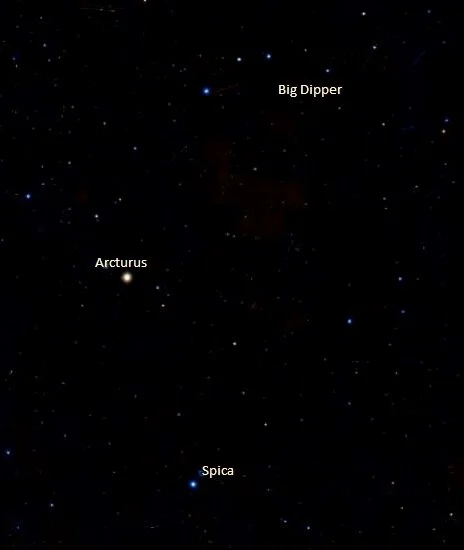
Finding Arcturus and Spica using the bright stars of the Big Dipper, image: Wikisky
Spica was most likely the star that helped the Greek astronomer and mathematician Hipparchus discover precession of the equinoxes in 127 BC. Precession of the equinoxes, or axial precession, is the gradual change in the orientation of Earth’s axis of rotation. Hipparchus measured the longitude of bright stars, Spica and Regulus in the constellation Leo among others, and when he compared the data to measurements of his predecessors, he found that Spica had moved 2° relative to the autumnal equinox (astronomical event around September 22 when the tilt of the earth’s axis is inclined neither away from nor towards the Sun, with the centre of the Sun in the same plane as the Earth’s equator).
Nicolaus Copernicus, who was the first to propose a comprehensive heliocentric cosmology, displacing the Earth from the centre of the universe, also made numerous observations of Spica while researching precession.
The easiest way to find Spica in the sky is to follow the arc of the Big Dipper’s handle to Arcturus in the constellation Boötes and continue along the same line to Spica.
Zavijava – β Virginis (Beta Virginis)
Beta Virginis belongs to the spectral class F9 V and is only 35.65 light years distant from the Sun. Even though it is designated beta, it is only the fifth brightest star in the constellation.
The star’s traditional name, Zavijava (sometimes Zavijah, Zavyava or Zawijah), is derived from the Arabic zāwiyat al-cawwa’, which means “the corner of the barking dog.” It was also sometimes known as Alaraph.
Porrima – γ Virginis (Gamma Virginis)
Porrima, Gamma Virginis, is a binary star. Porrima is the name of two goddesses of prophecy, the Carmenae. The star is also sometimes known as Postvarta, Arich and Laouiyet al Aoua. The latter was translated into Latin as Angulus Latratoris and it means “the angle of the barker.”
Together with Beta, Eta, Delta and Epsilon Virginis, the star formed an asterism known as Barker, or Al ʽAwwāʼ. Gamma Virginis has a visual magnitude of 2.74 and is approximately 38.1 light years distant.
Both stars in the Gamma Virginis system are of the spectral type F0V and have similar visual magnitudes, 3.65 and 3.56.
Minelauva – δ Virginis (Delta Virginis)
Delta Virginis is a red giant belonging to the spectral class M3 III, approximately 198 light years distant. It has an apparent magnitude of 3.4 and can be seen without binoculars. It has a mass 1.4 times solar, but with a radius 48 times that of the Sun, it is about 468 times more luminous. Delta Virginis is a high-velocity star, moving at the speed of more than 30 km s–1 relative to the motion of the neighbouring stars.
The star is classified as a semiregular variable and its brightness varies between 3.32 and 3.40. It is a suspected binary star with an 11th magnitude star – a K-type dwarf – located 80 arc seconds away. The dwarf is believed to orbit the star with a period of over 200,000 years, but this has not been confirmed.
The star’s traditional name, Auva, and its variants Al Awwa and Minelauva, are derived from the Arabic عوى cawwa’, which means “barking (dog)” or simply “the barker.”
Vindemiatrix – ε Virginis (Epsilon Virginis)
Epsilon Virginis is the third brightest star in Virgo. It has a visual magnitude of 2.826 and is 109.6 light years distant. The star is a giant belonging to the spectral class G8 III. It is about 77 times more luminous than the Sun.
The star’s name, derived from the Latin vindēmiātrix, means “the grape gatherer” or “the grape harvestress.”
Heze – ζ Virginis (Zeta Virginis)
Zeta Virginis is a main sequence star of the spectral type A3 V. It has an apparent magnitude of 3.376 and is 74.1 light years distant. The origin of its traditional name, Heze, is unknown.
Zeta Virginis has twice the mass and radius of the Sun. It can be seen without binoculars.
Zaniah – η Virginis (Eta Virginis)
Eta Virginis is a triple star system in Virgo. It has a visual magnitude of 3.890 and is visible to the unaided eye. It has the stellar classification A2 V.
The three stars form a very close system and can’t be resolved in a telescope. The system is 265 light years distant.
The inner two stars are only 0.5 astronomical units apart and orbit each other with a period of 72 days. The third star is a bit more distant and orbits the inner pair with a period of 13.1 years.
The star’s traditional name, Zaniah, comes from the Arabic zāwiyah, which means “the corner.”
Syrma – ι Virginis (Iota Virginis)
Iota Virginis belongs to the spectral class F6 III and is 69.8 light years distant. It has an apparent magnitude of 2.44.The star’s traditional name, Syrma, comes from the Arabic word sirmā, which means “train (of a garment).”
Rijl al Awwa – μ Virginis (Mu Virginis)
Mu Virginis is a yellow star belonging to the spectral class F2III. It has an apparent magnitude of 3.87 and is approximately 60.9 light years distant. Its traditional name, Rijl al Awwa (rijl al-‘awwa’), means “the foot of the barking dog.”
70 Virginis
70 Virginis is a yellow dwarf of the spectral type G2.5Va. It has a visual magnitude of 5.00 and is 58.7 light years distant. The star is believed to be evolving into a subgiant because it is brighter than most stars of its spectral type. An extrasolar planet was discovered in the star’s orbit in 1996.
χ Virginis (Chi Virginis)
Chi Virginis is another binary star in Virgo. It is approximately 294 light years distant and has an apparent magnitude of 4.652, which makes it visible to the unaided eye.
Chi Virginis belongs to the spectral class K2 III, which means that it is an orange giant, one that has a mass double that of the Sun. Its radius is 23 times solar and it is 182 times more luminous than the Sun.
The primary star in the system has three visual companions, a K0-type star with a visual magnitude of 9.1 about 173.1 arc seconds away, a 10th magnitude star 221.2 arc seconds away, and a K2-type star with a magnitude of 9.1, located 321.2 arc seconds away.
A massive planet was discovered in the star’s orbit in July 2009. It has a mass at least 11 times that of Jupiter and it orbits the star with a period of 835 days.
61 Virginis
61 Virginis is a yellow main sequence dwarf belonging to the spectral class G5V approximately 27.9 light years distant. It is believed to be a disk star. It has a visual magnitude of 4.74.
61 Virginis is almost identical in composition to the Sun and slightly less massive. It rotates at the equator every 29 days. The star’s age is estimated at more than six billion years.
61 Virginis is the first well established yellow dwarf almost identical to the Sun with a potential Super Earth (extrasolar planet more massive than Earth, but considerably below the mass of the smaller gas giants – Uranus and Neptune – in the Solar System) in its orbit.
109 Virginis
109 Virginis is a white main sequence dwarf of the spectral type A0V. It has a visual magnitude of 3.73, which makes it the seventh brightest star in the constellation. The star is 129 light years distant from the solar system. It is 23 times more luminous than the Sun.
ν Virginis (Nu Virginis)
Nu Virginis is a red giant belonging to the spectral class M1IIIab. It is a semiregular variable star with a mean apparent magnitude of 4.04, approximately 313 light years distant from Earth. Its brightness varies by 0.06 magnitudes.
Deep sky objects in Virgo
Virgo Cluster
The Virgo Cluster is a galaxy cluster found in the constellations Coma Berenices and Virgo. The cluster’s centre is located approximately 53.8 million light years away from the solar system, at the centre of the Virgo Supercluster, the larger cluster of galaxies that also contains the Local Group, which in turn includes the Andromeda Galaxy and the Milky Way.
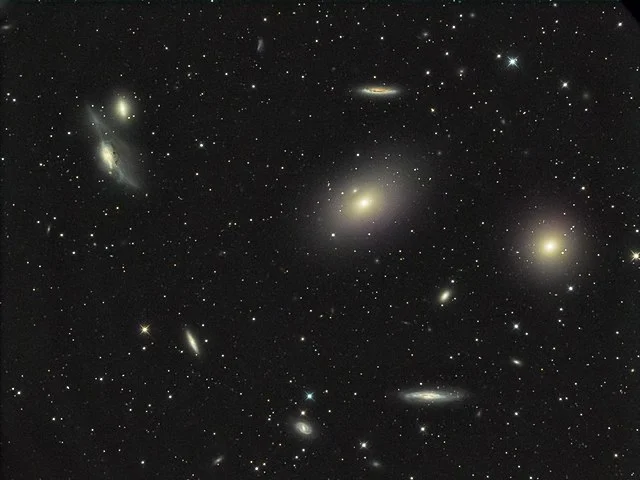
The centre of the Virgo Cluster, image: Carsten Frenzl (CC BY 2.0)
The Virgo Cluster contains about 1300 galaxies, possibly even up to 2000.
The brightest ones were for the most part discovered in the late 18th and early 19th century and could be found in Messier’s catalogue, described as nebulae without stars.
Other than the Messier objects in Virgo (see below), the cluster also contains several notable ones located in the constellation Coma Berenices: Messier 85, M88, M91, M98, M99, and M100.
Messier 49 (M49, NGC 4472)
Messier 49 is the brightest galaxy in the Virgo Cluster and the first galaxy to be discovered in the cluster. It is an elliptical galaxy with a visual magnitude of 9.4, about 55.9 million light years distant. It was discovered by Charles Messier in February 1771. It is currently gravitationally interacting with the small dwarf irregular galaxy UGC 7636.
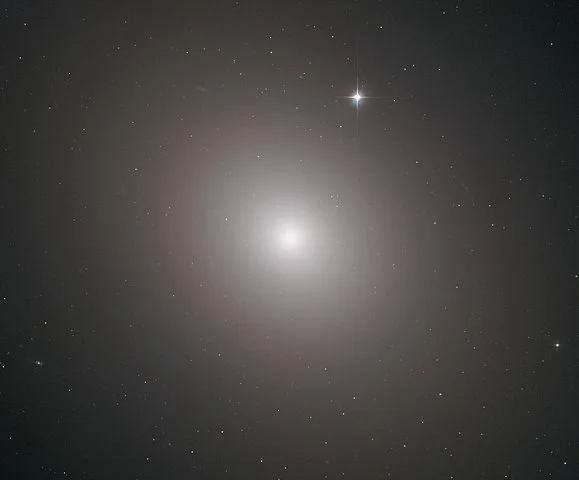
This fuzzy orb of light is a giant elliptical galaxy filled with an incredible 200 billion stars. Unlike spiral galaxies, which have a well-defined structure and boast picturesque spiral arms, elliptical galaxies appear fairly smooth and featureless. This is likely why this galaxy, named Messier 49, was discovered by French astronomer Charles Messier in 1771. At a distance of 56 million light-years, and measuring 157,000 light-years across, M49 was the first member of the Virgo Cluster of galaxies to be discovered, and it is more luminous than any other galaxy at its distance or nearer. Image: ESA/Hubble & NASA, J. Blakenslee, P Cote et al., 2019
M49 contains about 5900 globular clusters, 10 billion years old on average. Two candidates for stellar mass black holes, ones formed by gravitational collapses of massive stars, were discovered in a M49 cluster in the last decade.
The galaxy is believed to have a supermassive black hole with 565 million solar masses at its core. Only one supernova has been spotted in the galaxy, SN 1969Q in June 1969.
M49 can be found 4.1° west-southwest of the bright star Epsilon Virginis.
Messier 58 (M58, NGC 4579)
Messier 58 is a barred spiral galaxy in Virgo. It is one of the brightest galaxies in the Virgo Cluster. It has an apparent magnitude of 10.5 and is about 62 million light years distant.
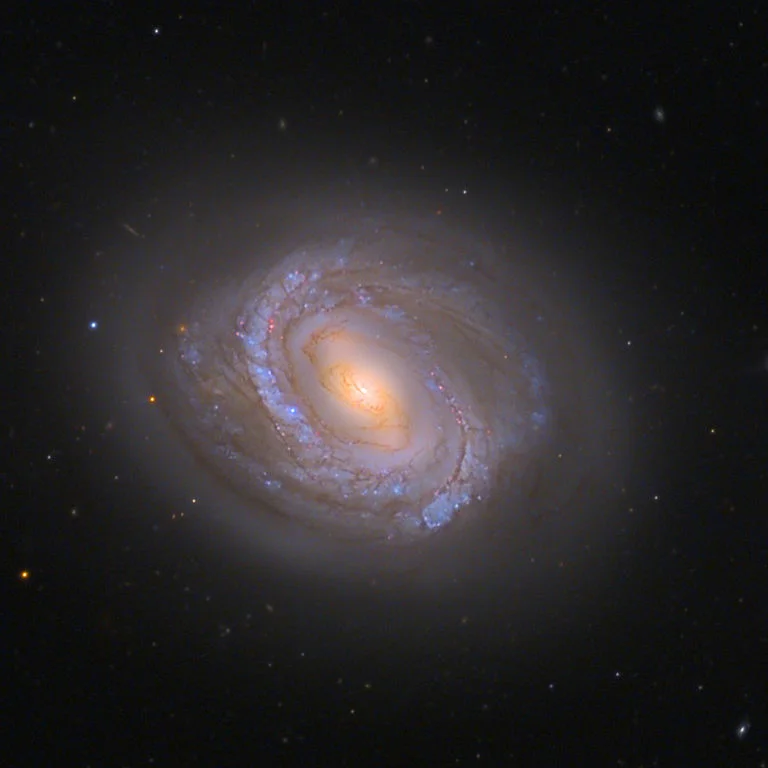
Messier 58, image: Adam Block/Mount Lemmon SkyCenter/University of Arizona (CC BY-SA 4.0)
M58 was discovered along with the elliptical galaxies M59 and M60 by Charles Messier in April 1779. Two supernovae have been observed in the galaxy: SN 1988A in January 1988 and SN 1989M in June 1989.
Messier 59 (M59, NGC 4621)
Messier 59 is an elliptical galaxy about 60 million light years away from the solar system, located in the Virgo Cluster. It has a visual magnitude of 10.6. Both M59 and M60 were discovered by the German astronomer Johann Gottfried Koehler in April 1779, and subsequently included in the Messier catalogue.
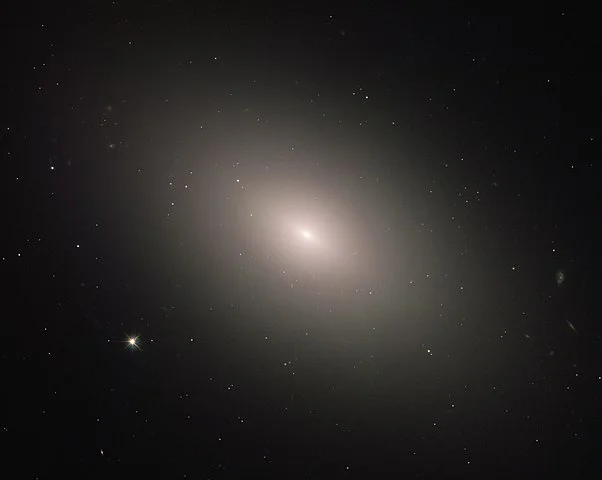
This luminous orb is the galaxy NGC 4621, better known as Messier 59. As this latter moniker indicates, the galaxy was listed in the famous catalogue of deep-sky objects compiled by French comet-hunter Charles Messier in 1779. However, German astronomer Johann Gottfried Koehler is credited with discovering the galaxy just days before Messier added it to his collection. Modern observations show that Messier 59 is an elliptical galaxy, one of the three main kinds of galaxies along with spirals and irregulars. Ellipticals tend to be the most evolved of the trio, full of old, red stars and exhibiting little or no new star formation. Messier 59, however, bucks this trend somewhat; the galaxy does show signs of star formation, with some newborn stars residing within a disc near the core. Image: ESA/Hubble & NASA, P. Cote
Messier 60 (M60, NGC 4649)
Messier 60 is another elliptical galaxy in the Virgo Cluster. It has an apparent magnitude of 9.8 and is about 55 million light years distant. It is the third brightest giant elliptical galaxy in the cluster. A supernova was discovered in it in 2004.
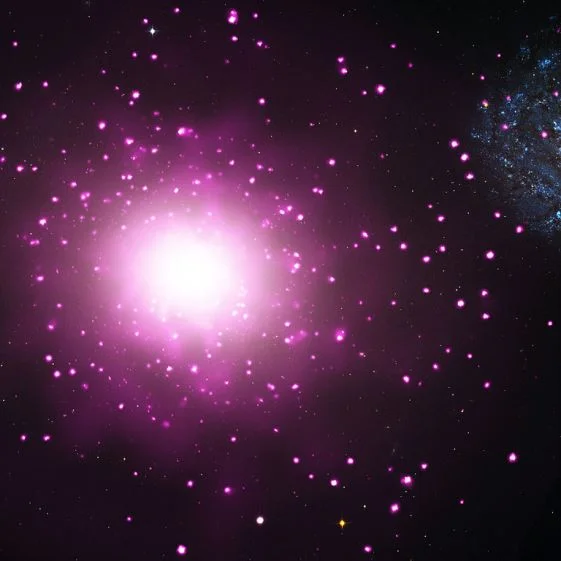
This composite image shows Messier 60 and the region around it, where data from NASA’s Chandra X-ray Observatory are pink and data from NASA’s Hubble Space Telescope are red, green and blue. Image: NASA, ESA, CXC, and J. Strader (Michigan State University)
The galaxy’s optical disk overlaps with the disk of NGC 4647, located about 2′.5 from M60, but since there is no evidence of gravitational interaction between the galaxies, the two are believed to be at different distances from the solar system.
Messier 61 (M61, NGC 4303)
Messier 61 is a spiral galaxy. It also belongs to the Virgo Cluster and is one of its larger member galaxies. It has an apparent magnitude of 10.18 and is approximately 52.5 million light years distant.
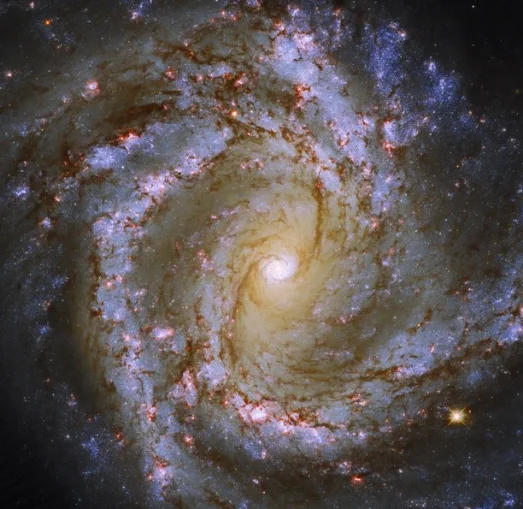
The luminous heart of the galaxy M61 dominates this image, framed by its winding spiral arms threaded with dark tendrils of dust. As well as the usual bright bands of stars, the spiral arms of M61 are studded with ruby-red patches of light. Tell-tale signs of recent star formation, these glowing regions lead to M61’s classification as a starburst galaxy. Though the gleaming spiral of this galaxy makes for a spectacular sight, one of the most interesting features of M61 lurks unseen at the centre of this image. As well as widespread pockets of star formation, M61 hosts a supermassive black hole more than 5 million times as massive as the Sun. Image: ESA/Hubble & NASA, ESO, J. Lee and the PHANGS-HST Team, 2021
M61 was discovered by the Italian astronomer Barnabus Oriani in May 1779. Six supernovae have been discovered in the galaxy in the last hundred years: SN 1926A, SN 1961I, SN 1964F, SN 1999gn, SN 2006ov, and SN 2008in.
Messier 84 (M84, NGC 4374)
Messier 84 is a lenticular galaxy located in the inner core of the Virgo cluster. It was discovered by Charles Messier in March 1781. M84 has a visual magnitude of 10.1 and is approximately 60 million light years distant.
The galaxy has a disk of fast rotating gas and stars, which means that it likely contains a supermassive black hole at its centre. Two supernovae have been discovered in M84: SN 1957 and SN 1991bg.
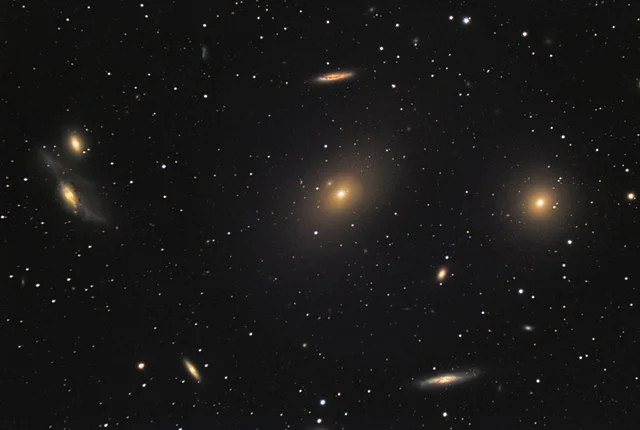
Messier 86 (centre), Messier 84 (right), the Eyes Galaxies (NGC 4435 and NGC 4438, left), NGC 4402 (top), NGC 4425 (bottom left), and NGC 4388 (bottom right), image: Radan Mitroviќ (CC BY-SA 4.0)
Messier 86 (M86, NGC 4406)
Messier 86 is another lenticular galaxy near the centre of the Virgo Cluster, also discovered by Charles Messier in 1781. It is approaching our galaxy at the speed of 244 kilometres per second, as a result of falling toward the heart of the Virgo Cluster from the opposite side.
The galaxy has a visual magnitude of 9.8 and is about 52 million light years away.
Messier 87 (Virgo A, M87, NGC 4486)
Messier 87 is a supergiant elliptical galaxy located near the centre of the Virgo Cluster of galaxies, near the border between Virgo and Coma Berenices. With a visual magnitude of 9.59, it is the second brightest galaxy in the cluster, and also one of the brightest radio sources known. It can be observed in a small telescope.
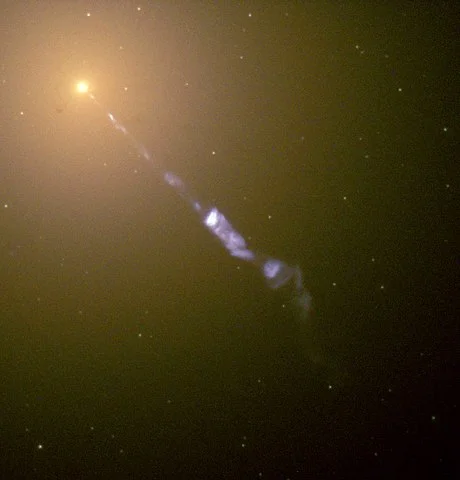
The jet emerging from the galactic core of M87 (NGC 4486). The jet extends to about 20 arc seconds (absolute length ca. 5 kly). Composite image of Hubble Telescope observations. The galaxy is too distant for the Hubble Telescope to resolve individual stars; the bright dots in the image are star clusters, assumed to contain some hundreds of thousands of stars each. Image: NASA and The Hubble Heritage Team (STScI/AURA)
M87 is also one of the most massive galaxies in the local universe. It was discovered by Charles Messier in 1781. It is about 53.5 million light years distant. The motion of planetary nebulae between Messier 87 and Messier 86 indicates that the two galaxies are moving toward each other.
M87 is classified as a type-cD galaxy, or a supergiant D class galaxy that has a large halo of stars and an elliptical nucleus with a large diffuse envelope that contains no dust.
M87 has a supermassive black hole at its centre. In April 2017, it became the first black hole to be directly imaged. The image was captured by the Event Horizon Telescope (EHT), a worldwide network of eight ground-based radio telescopes. In 2019, the black hole — one of the most massive ones known — was named Pōwehi. The name comes from a Hawaiian creation chant and means “embellished dark source of unending creation.”
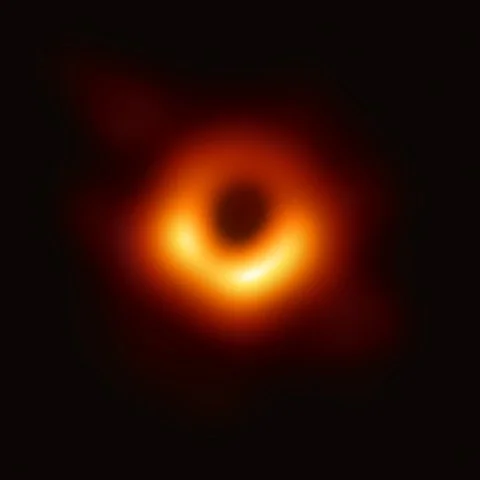
The Event Horizon Telescope (EHT) — a planet-scale array of eight ground-based radio telescopes forged through international collaboration — was designed to capture images of a black hole. In coordinated press conferences across the globe, EHT researchers revealed that they succeeded, unveiling the first direct visual evidence of the supermassive black hole in the centre of Messier 87 and its shadow. In this image of M87* taken on 11 April 2017 (a representative example of the images collected in a global 2017 EHT campaign), the shadow of a black hole is the closest we can come to an image of the black hole itself, a completely dark object from which light cannot escape. The black hole’s boundary — the event horizon from which the EHT takes its name — is around 2.5 times smaller than the shadow it casts and measures just under 40 billion km across. While this may sound large, this ring is only about 40 microarcseconds across — equivalent to measuring the length of a credit card on the surface of the Moon. Image: Event Horizon Telescope
M87 can be found by following the line from Vindemiatrix in Virgo to the bright Denebola in the constellation Leo.
Messier 89 (M89, NGC 4552)
Messier 89 is another elliptical galaxy in Virgo. Messier discovered it in March 1781. The galaxy belongs to the Virgo Cluster. It has a visual magnitude of 10.73 and is approximately 50 million light years distant. There are about 2000 globular clusters within 25’ of the galaxy. For comparison, the Milky Way only has 150-200.
M89 is suspected to once have been a radio galaxy or active quasar. It has a surrounding disk of gas and dust that extends about 150,000 light years from the galaxy and jets of hot particles extending about 100,000 light years outward.
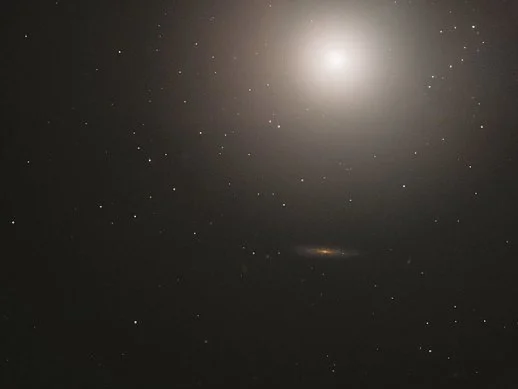
This huge ball of stars — around 100 billion in total — is an elliptical galaxy located some 55 million light-years away from us. Known as Messier 89, this galaxy appears to be perfectly spherical; this is unusual for elliptical galaxies, which tend to be elongated ellipsoids. The apparently spherical nature of Messier 89 could, however, be a trick of perspective, and be caused by its orientation relative to the Earth. Image: ESA/Hubble & NASA, S. Faber et al.
Messier 90 (M90, NGC 4569)
Messier 90 is a spiral galaxy with a visual magnitude of 10.26, approximately 58.7 million light years distant. Messier discovered it in 1781. It is a member of the Virgo Cluster. It is located about a degree and a half from the M87 subgroup.
The galaxy’s spiral arms are pretty featureless and star forming regions appear truncated as a result of interaction with the intracluster medium in the Virgo Cluster. For this reason, M90 has been classified as an anemic galaxy, a spiral characterized by a low contrast between the disk and the galaxy’s spiral arms. It serves as the prototype for the group.
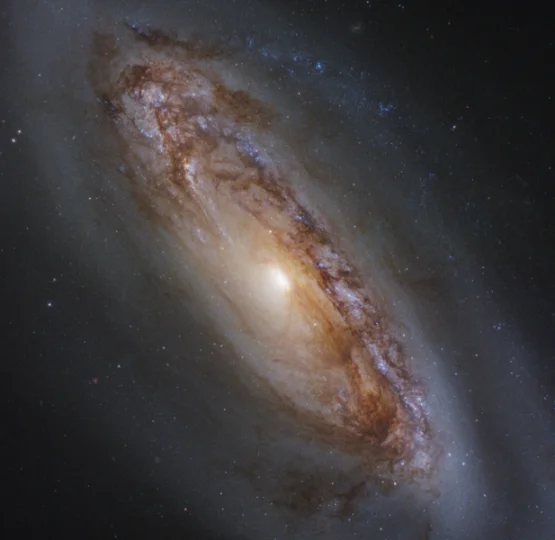
Also known as M90 or Messier 90, this spiral galaxy exhibits less star formation than usual due to a phenomenon called ram pressure stripping. Gas that could have collapsed to form stars was instead stripped away as the galaxy moved through the intracluster medium between galaxies. Space may be mostly empty, but a galaxy moving fast enough through it can feel it. Image: Judy Schmidt (CC BY 2.0)
Sombrero Galaxy – Messier 104 (M104, NGC 4594)
Messier 104 is an unbarred spiral galaxy with a visual magnitude of 8.98, approximately 29.3 million light years distant. It can easily be seen in an amateur telescope. It is located in the southern part of the Virgo Cluster, about 11.5° west of Spica. The galaxy contains between 1,200 and 2,000 globular clusters.
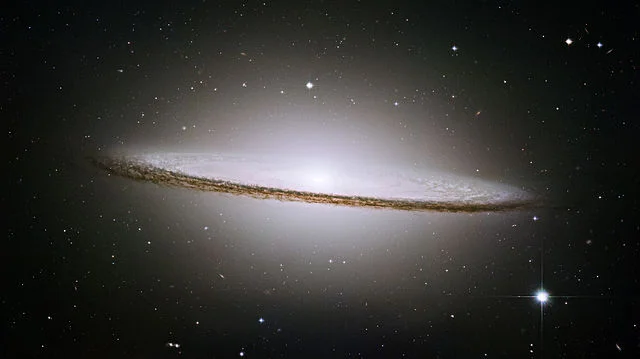
The famous Sombrero galaxy (M104) is a bright nearby elliptical galaxy. The prominent dust lane and halo of stars and globular clusters give this galaxy its name. Something very energetic is going on in the Sombrero’s center, as much X-ray light has been detected from it. This X-ray emission coupled with unusually high central stellar velocities cause many astronomers to speculate that a black hole lies at the Sombrero’s center – a black hole a billion times the mass of our Sun. Image: NASA/ESA and The Hubble Heritage Team (STScI/AURA)
M104 got the name Sombrero because its unusually large central bulge and the dust lane in its disk make it look like a sombrero. Astronomers believe that it may really be a giant elliptical galaxy. It contains a supermassive black hole at its centre.
The Sombrero Galaxy was discovered by Pierre Méchain in March 1767 and later included in the Messier catalogue.
Eyes Galaxies (NGC 4435 – NGC 4438, Arp 120)
The Eyes Galaxies are a pair of interacting galaxies – NGC 4435 and NGC 4438 – located in the Virgo Cluster.
NGC 4435 is a barred lenticular galaxy. It contains a number of young stars in its central regions. The starburst activity is suspected to be a result of the interaction with the neighbouring galaxy NGC 4438.
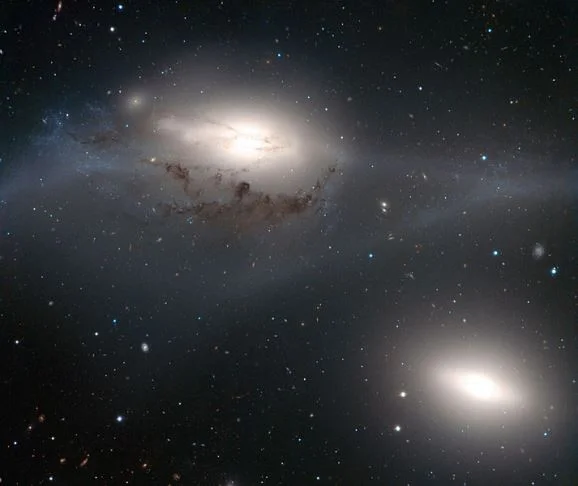
This striking image, taken with the FORS2 instrument on the Very Large Telescope, shows a beautiful yet peculiar pair of galaxies, NGC 4438 and NGC 4435, nicknamed The Eyes. The larger of these, at the top of the picture, NGC 4438, is thought to have once been a spiral galaxy that was strongly deformed by collisions in the relatively recent past. Photo: ESO/Gems project
NGC 4438 has a distorted disk and tidal tails as a result of interacting with other galaxies, and it is difficult to classify it as a spiral or lenticular galaxy.
The galaxies are about 52 million light years distant.
NGC 4216
NGC 4216 is an intermediate spiral galaxy in the Virgo Cluster, approximately 40 million light years from the solar system. It has a visual magnitude of 11.
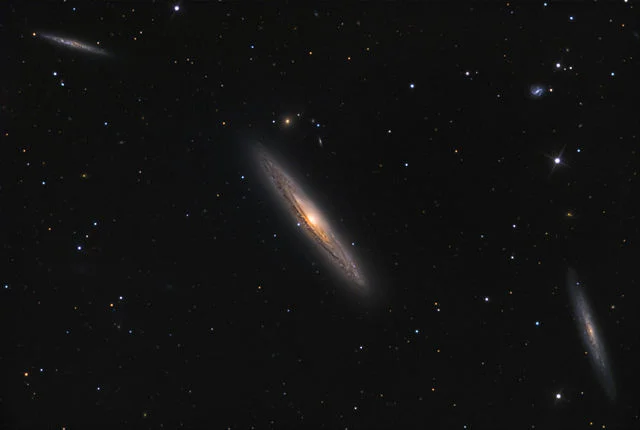
NGC 4216, image: Adam Block/Mount Lemmon SkyCenter/University of Arizona (CC BY-SA 3.0 US)
With an estimated absolute magnitude of -22, it is one of the largest and brightest galaxies in the cluster.
The galaxy is metal-rich and shows a deficiency of neutral hydrogen in its optical disk, like most galaxies in the cluster. It is believed to be interacting with and absorbing two smaller satellite galaxies.
Butterfly Galaxies – NGC 4567 and NGC 4568
NGC 4567 and NGC 4568 form a pair of spiral galaxies in the Virgo Cluster, located approximately 59.4 million light years from the solar system.
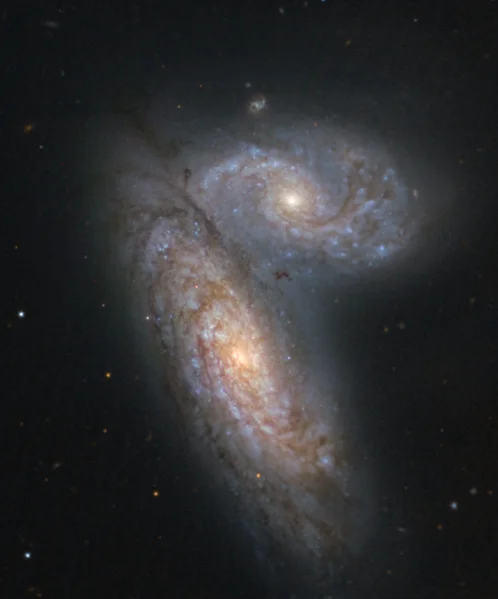
NGC 4567 and NGC 4568, image: Judy Schmidt (CC BY 2.0)
The galaxies are in the process of colliding with each other. Their apparent magnitude is 10.9. They were discovered by William Herschel in 1784. A supernova was observed in the galaxies in 2004.
NGC 4526
NGC 4526 is a lenticular galaxy. It belongs to the Virgo cluster. The galaxy has a visual magnitude of 10.7 and is about 55 million light years distant. Two supernovae were discovered in the galaxy: SN 1969E in 1969 and SN 1994D in 1994.
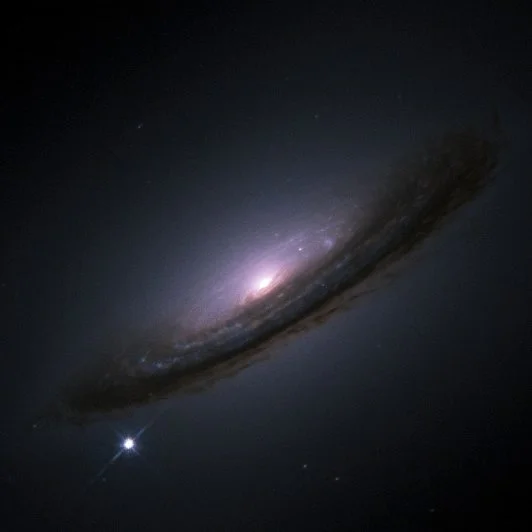
Hubble Space Telescope-Image of Supernova 1994D (SN1994D) in galaxy NGC 4526 (SN 1994D is the bright spot on the lower left), image: NASA/ESA, The Hubble Key Project Team and The High-Z Supernova Search Team
NGC 4261
NGC 4261 is an elliptical galaxy with a visual magnitude of 11.4, approximately 96 million light years distant. It lies behind the Virgo Cluster. The galaxy is about 60,000 light years across. It contains a supermassive black hole at its centre, one with 400 solar masses.
3C 273
3C 273 is a quasar (an energetic and distant active galactic nucleus, or quasi-stellar radio source), the first one ever to be identified, as well as the brightest and most luminous quasar in the sky. It is also one of the nearest of its kind, located about 2.443 gigalight years away.
The quasar was one of the first extragalactic X-ray sources discovered in 1970. It lies at the heart of a large elliptical galaxy.
3C 273 is classified as a blazar, a very compact quasar associated with a suspected supermassive black hole at the centre of an active giant elliptical galaxy.
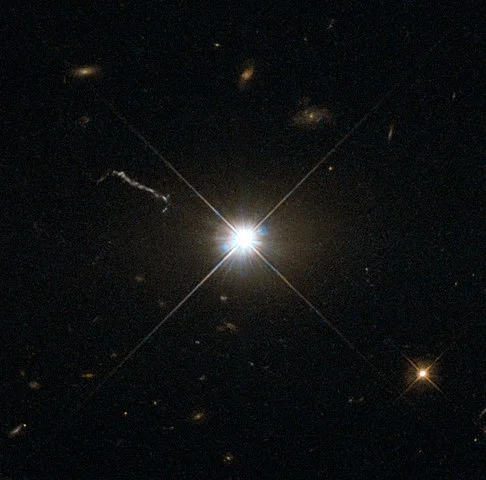
This image from Hubble’s Wide Field and Planetary Camera 2 (WFPC2) is likely the best of ancient and brilliant quasar 3C 273, which resides in a giant elliptical galaxy in the constellation of Virgo (The Virgin). Its light has taken some 2.5 billion years to reach us. Despite this great distance, it is still one of the closest quasars to our home. It was the first quasar ever to be identified, and was discovered in the early 1960s by astronomer Allan Sandage. Image: ESA/Hubble & NASA